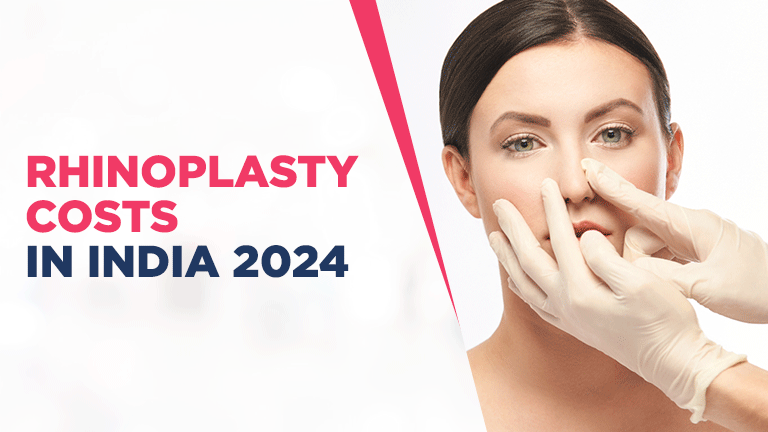With the increasing popularity of aesthetic surgeries, many individuals in India are considering rhinoplasty treatment in Delhi to achieve their desired look. However, one of the most crucial aspects to consider before undergoing this transformative procedure is the cost.
In this comprehensive guide, we will delve into the various factors that influence the cost of rhinoplasty in India in 2024, providing you with a clear picture of what to expect. Whether you’re looking for a minor adjustment or a complete nasal reconstruction, this article will equip you with the knowledge needed to navigate the costs associated with rhinoplasty.
Average Rhinoplasty Cost in India
Rhinoplasty, also known as nose jobs or nose reshaping, is a popular cosmetic procedure in India. In 2024, the average cost of rhinoplasty in India ranges between ₹40,000 to ₹2,50,000. Several factors influence the cost of rhinoplasty, including:
- Surgeon’s Expertise and Reputation: Highly experienced and renowned surgeons often charge higher fees due to their advanced skills and proven track records of successful surgeries.
- Clinic or Hospital Location: The cost of rhinoplasty can vary significantly based on the geographical location of the clinic. Urban centers like Mumbai, Delhi, and Bangalore tend to have higher costs compared to smaller cities and towns.
- Complexity of the Procedure: The nature and extent of the surgical intervention required can impact the cost. Complex procedures involving extensive reshaping or reconstruction will be more expensive than minor adjustments.
- Type of Anesthesia Used: The choice between local and general anesthesia also affects the overall cost. General anesthesia typically incurs higher fees due to the need for an anesthesiologist and additional monitoring.
- Post-operative Care and Follow-ups: Comprehensive post-operative care, including follow-up consultations and potential revisions, contribute to the total cost. High-quality care ensures better outcomes and fewer complications.
Also Read : Is Rhinoplasty Safe for Diabetic Patients?
Rhinoplasty Cost Breakdown
1. Pre-surgery Costs
Before the actual surgery, there are several essential expenses that patients must consider:
- Consultation Fees: The initial consultation with the surgeon, where your goals and the procedure details are discussed, usually incurs a fee. This can range from ₹1,000 to ₹5,000 depending on the surgeon’s expertise and location.
- Diagnostic Tests: Pre-surgery diagnostic tests such as blood tests, imaging (X-rays or CT scans), and other required medical evaluations can cost between ₹3,000 to ₹10,000.
- Medication and Preparation Costs: Pre-surgery medications, including antibiotics and any necessary pre-operative preparations, can add an additional ₹1,000 to ₹3,000 to the total cost.
2. Surgery Cost
The primary expenses of the rhinoplasty procedure itself include:
- Surgeon’s Fee: The surgeon’s fee is a significant part of the total cost and can vary widely based on the surgeon’s experience, reputation, and the complexity of the procedure. This fee generally ranges from ₹50,000 to ₹1,50,000.
- Anesthesia Fee: The type of anesthesia used (local or general) affects the cost. Anesthesia fees typically range from ₹10,000 to ₹30,000.
- Operation Theatre Charges: The use of the operation theatre and its facilities contributes to the overall expense. These charges can range from ₹20,000 to ₹50,000.
3. Day Care or Hospital Stay Charges
Post-surgery care is crucial for a successful recovery and involves several costs:
- Hospital Room Charges: Depending on the type of room chosen (general ward, semi-private, or private room), the charges can vary. Typically, room charges range from ₹5,000 to ₹20,000 per day.
- Post-surgery Care: This includes follow-up visits, removal of stitches, and any additional treatments required for a smooth recovery, costing around ₹5,000 to ₹15,000.
- Additional Medical Expenses: Any extra medications, dressings, or special care requirements during the hospital stay may add another ₹2,000 to ₹5,000.
Total Estimated Cost of Rhinoplasty Surgery
When combining all the aforementioned costs, the total estimated cost of rhinoplasty surgery in India can range from ₹70,000 to ₹2,50,000. This estimate includes pre-surgery consultations and tests, the actual surgical procedure, and post-surgery care.
However, potential variations in the total cost can occur due to factors such as the surgeon’s expertise, the complexity of the surgery, the type of anesthesia used, and the location of the clinic or hospital. Patients are encouraged to discuss all potential costs with their surgeon during the initial consultation to ensure they have a clear understanding of the financial commitment involved.
Different Types of Nose Surgery (Rhinoplasty) Cost in India
If you’re contemplating nose surgery in India, it’s essential to grasp the cost structure for various procedures to plan your budget efficiently. Below, we provide an estimated range of average, minimum, and maximum costs for the most common types of nose surgeries performed in the country:
Cost of Different Types of Nose Surgery in India
| Type of Treatment | Average Cost | Minimum Cost | Maximum Cost |
| Septoplasty | ₹45,500 | ₹35,500 | ₹60,500 |
| Fess Surgery | ₹55,500 | ₹45,500 | ₹70,500 |
| Rhinoseptoplasty | ₹137,000 | ₹70,500 | ₹250,000 |
| Turbinate Reduction Surgery | ₹55,000 | ₹40,500 | ₹65,000 |
| Nose Fracture Management | ₹125,000 | ₹40,500 | ₹250,000 |
| Nasal Polypectomy | ₹55,500 | ₹45,500 | ₹75,000 |
Cost Breakdown for Rhinoplasty in Major Cities of India
If you’re planning to undergo rhinoplasty in India, it’s important to understand the cost variations across different cities to make a well-informed decision. Here, we break down the average cost range for rhinoplasty in major cities of India:
Rhinoplasty Cost in Major Cities of India
| City | Cost Range (INR) |
| Delhi | ₹35,000 – ₹1,50,000 |
| Bangalore | ₹40,000 – ₹2,00,000 |
| Mumbai | ₹30,000 – ₹1,70,000 |
| Gurgaon | ₹40,000 – ₹2,00,000 |
| Chennai | ₹75,000 – ₹2,00,000 |
| Hyderabad | ₹30,000 – ₹2,00,000 |
| Pune | ₹35,000 – ₹1,50,000 |
By understanding the cost variations for different types of nose surgeries and the price differences across various cities, you can better plan your rhinoplasty procedure in India, ensuring you get the best value for your investment.
How to Minimize Rhinoplasty Cost in India?
1. Research and Compare Prices
To find the best deal for your rhinoplasty, it’s crucial to research and compare prices between different clinics. Here are some tips:
- Consult Multiple Clinics: Schedule consultations with several clinics to get a range of quotes.
- Check Online Reviews: Look at patient reviews and testimonials to gauge the quality and cost-effectiveness of various clinics.
- Ask for Detailed Estimates: Ensure each clinic provides a comprehensive breakdown of all costs involved.
2. Choose a Reputable Surgeon
Selecting a qualified and experienced surgeon is vital for a successful rhinoplasty. Here’s why:
- Expertise Reduces Risk: An experienced surgeon minimizes the risk of complications, potentially saving you from costly revisions.
- Long-term Satisfaction: A skilled surgeon ensures better aesthetic results, reducing the need for future corrections.
- Professional Advice: Reputable surgeons provide thorough pre- and post-operative care, which is crucial for a smooth recovery.
3. Consider Alternative Locations
Opting for clinics in smaller cities or towns can lead to significant cost savings:
- Lower Overheads: Clinics in smaller cities generally have lower operational costs, which can translate to lower surgery fees.
- Comparable Quality: Many smaller cities have highly qualified surgeons offering excellent care at reduced prices.
- Travel Costs: Factor in travel and accommodation costs when considering clinics outside major urban centers.
4. Discuss Financing Options
Explore available financing options and payment plans to make the procedure more affordable:
- Installment Plans: Many clinics offer payment plans that allow you to spread the cost over several months.
- Medical Loans: Specialized medical loans are available to cover cosmetic surgery expenses.
- Credit Options: Some clinics accept credit card payments, providing additional flexibility in managing expenses.
5. Opt for Local Anesthesia
Choosing local anesthesia can be more cost-effective than general anesthesia:
- Lower Fees: Local anesthesia generally incurs lower costs compared to general anesthesia.
- Faster Recovery: Patients typically recover more quickly from local anesthesia, potentially reducing post-operative care costs.
- Fewer Risks: Local anesthesia reduces the risk of complications, leading to lower overall expenses.
6. Combine Procedures
Combining rhinoplasty with other cosmetic procedures can offer cost advantages:
- Shared Costs: Combining procedures can reduce the overall cost by sharing anesthesia, facility, and surgeon fees.
- Comprehensive Results: Undergoing multiple procedures at once can enhance overall aesthetic results, minimizing the need for future surgeries.
- Single Recovery Period: Combining procedures means only one recovery period, reducing time off work and associated costs.
7. Follow Pre and Post-Operative Instructions
Adhering to medical advice can prevent complications and additional costs:
- Pre-operative Care: Following pre-surgery guidelines can optimize your health, reducing the risk of complications during surgery.
- Post-operative Care: Strictly following post-surgery care instructions ensures a smooth recovery and minimizes the likelihood of costly medical issues.
- Regular Check-ups: Attend all scheduled follow-up appointments to monitor your progress and address any concerns promptly.
Does Rhinoplasty Have Insurance Coverage?
When considering rhinoplasty, it’s essential to understand whether your health insurance can help cover the costs. Here’s a detailed look at the insurance policies and coverage for rhinoplasty in India:
Health insurance typically covers medically necessary procedures rather than purely cosmetic surgeries. Rhinoplasty, if performed for medical reasons such as correcting a deviated septum, repairing nasal fractures, or resolving breathing issues, may be covered by insurance. However, cosmetic rhinoplasty, which is performed solely for aesthetic purposes, is generally not covered by health insurance policies.
Types of Rhinoplasty Procedures Covered by Insurance
Insurance coverage for rhinoplasty depends on the underlying reason for the surgery. Here are some scenarios where insurance may provide coverage:
- Functional Rhinoplasty: If the procedure is necessary to correct functional issues such as breathing difficulties, obstructed nasal passages, or congenital defects, it is more likely to be covered by insurance.
- Reconstructive Rhinoplasty: This includes surgeries to repair damage caused by trauma, accidents, or medical conditions. Insurance companies often cover these types of procedures.
- Septoplasty: While technically a separate procedure, septoplasty to correct a deviated septum is frequently covered and can be performed in conjunction with rhinoplasty.
Steps to Claim Insurance for Rhinoplasty
To ensure your rhinoplasty procedure is covered by insurance, follow these steps:
- Consult with Your Surgeon: Discuss the medical necessity of your rhinoplasty with your surgeon. Obtain a detailed medical report and recommendation from your surgeon, specifying the functional or reconstructive need for the surgery.
- Check Your Insurance Policy: Review your health insurance policy to understand the specific coverage details. Contact your insurance provider to confirm whether your policy covers the type of rhinoplasty you need.
- Pre-authorization: Many insurance companies require pre-authorization for surgeries. Submit your surgeon’s report and any additional required documentation to your insurance provider to obtain pre-authorization.
- Document Everything: Keep thorough records of all consultations, diagnostic tests, and medical reports. This documentation will be crucial when filing your insurance claim.
- Submit the Claim: After the surgery, submit a detailed claim to your insurance company, including all medical reports, pre-authorization documents, and invoices. Ensure all forms are correctly filled out and all required documentation is attached.
- Follow Up: Stay in contact with your insurance provider to monitor the status of your claim. Provide any additional information they may request promptly to avoid delays in processing your claim.
By understanding your insurance coverage and following these steps, you can navigate the process of claiming insurance for medically necessary rhinoplasty procedures, potentially reducing your out-of-pocket expenses.
Conclusion
Planning for rhinoplasty in India requires careful consideration of various factors influencing the cost. By researching and comparing prices, choosing a reputable surgeon, considering alternative locations, discussing financing options, opting for local anesthesia, combining procedures, and following pre- and post-operative instructions, you can effectively manage and minimize the cost of your rhinoplasty. Making informed decisions will ensure you achieve the best possible results within your budget.




